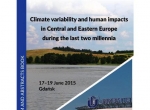Prezentacja wyników badań na konferencji - Gdańsk 2015
W dniach 17-19 czerwca 2015 r. na Uniwersytecie Gdańskim miała miejsce międzynarodowa konferencja p.t. „Zmienność klimatu i oddziaływanie człowieka w Środkowej i Wschodniej Europie w ostatnich dwóch tysiącleciach” (Climate variability and human impacts in Central and Eastern Europe in the last two millenia) http://www.climate2k.ug.edu.pl/ z udziałem blisko 100 uczestników z 14 krajów. Konferencja odbyła się pod auspicjami międzynarodowej organizacji PAGES (Past Global Changes), w ramach programu Euro-Med2k i polsko-szwajcarskiego programu badawczegoCLIMPOL (Climate of northern Poland during the last 1000 years: Constraining the future with the past), ze strony polskiej kierowanego przez dr. hab. prof. UG Wojciecha Tylmanna z Katedry Geomorfologii i Geologii Czwartorzędu UG http://www.kmk.umk.pl/badania/granty-mnisw-i-inne/projekty-realizowane-obecnie/15-climate-of-northern-poland-during-the-last-1000-years-constraining-the-future-with-the-past-climpol. Wykonawczynie projektu MPOV w składzie: dr Anna Pędziszewska, dr Joanna Święta-Musznicka, dr Marcelina Zimny i prof. dr hab. Małgorzata Latałowa, przedstawiły na nim referat p.t. Demographic changes during the first millennium AD and their impact on vegetation cover in north-western Poland (abstract poniżej), prezentujący wyniki badań prowadzonych w ramach projektu Maestro NCN „Okres Wędrówek Ludów między Odrą a Wisłą”.
„Demographic changes during the first millennium AD and their impact on
vegetation cover in north-western Poland”
In north-western Poland, the first millennium AD was a period of prominent demographic, cultural and economic changes which had an important impact on natural environment. In this area, the environmental effects of these processes were regionally differentiated not only because of variation in timing and scale of anthropogenic pressure, but also due to variation in some natural factors.
The aim of our lecture is to present a first attempt to
i. reconstruct changes in settlement dynamics pattern in both time and space through the northern part of Pomerania, between Vistula and Odra River, based on pollen data supplemented by other sedimentary proxies;
ii. assess the scale of changes in a forest cover in the period of interest;
iii. detect if potential small-scale agricultural activity could persist in a period of general economic decline (Migration Period);
iv. reconstruct pattern of migration and establishment of beech (Fagus sylvatica) in the area under concern and the role of natural factors and human activity in this process.
New high resolution palaeoecological data and some older records from the area are used for the purpose of this study. They indicate that in the Roman Iron Age the scale of human impact on the forest cover in the mouth of the Odra River was much lower than in the eastern part of the area, what resulted in the earlier onset of the reforestation having its optimum during the Migration Period. In the eastern part of the area the waves of intensive deforestations strongly affected forest habitats and delayed the subsequent woodland succession. The pollen data suggest that in some areas small-scale agriculture was probably continued through the most of the Migration Period. The new deforestation phase connected with the early medieval occupation started distinctly earlier in the western Pomerania. The clearly diachronic expansion of beech over the area was a result of complex factors with human activity among them.
Our data provide new, more precise insight to the earlier knowledge on the timing and scale of human impact during the first millennium AD and on the interactions between natural and anthropogenic factors driving forest succession in the region.
-
 pełna rozdzielczość
pełna rozdzielczość
Fot. 1. Konferencja poświęcona zmianom klimatycznym.


